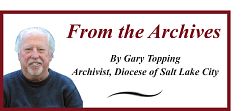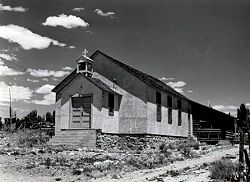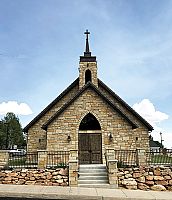Revisiting Monticello parish's colorful history
On Sept. 27, Bishop Oscar A. Solis dedicated our splendid new St. Joseph Parish church in Monticello. As we enter a new phase of our history, it is well that we look back at the struggling beginnings of the parish.
The first Catholics in Monticello were migratory Hispanic sheep and cattle herders who entered the area seasonally in the late 19th century from Colorado and New Mexico. Eventually they began to settle permanently with their families. By 1930 they comprised a significant population, but they had no church or pastor, and had to journey out of state for access to the sacraments. During the following years, Jose Prudencio Gonzalez and Ascension Martinez built a small church on Main Street; Father John Sanders became its first resident pastor in 1938. By 1940, though, poor health forced Fr. Sanders to withdraw, and Bishop Duane G. Hunt found himself hard-pressed to find a replacement, especially because he perceived that Spanish fluency was almost imperative, and there were no diocesan priests with that linguistic skill.
A crisis developed in the interim, because with no pastor the Monticello Catholics found themselves vulnerable, first to Pentecostal evangelists and later to Mormon missionaries who successfully tempted a significant number of them away from their Catholic faith. Almost desperately, Bishop Hunt began applying to various religious orders for a priest with the proper qualifications, at various times approaching the Franciscans, the Theatines and the Claretians.
Although the Franciscans would have their turn at a later date, the Claretians were the only ones to respond positively at that time. They sent two priests, Fr. Peter Caballer, CMF and Fr. Boniface Mayer, CMF, who arrived in Monticello on June 4, 1941.
Problems developed from the very beginning. In the first place, realizing that St. Joseph Parish was financially strapped, Bishop Hunt counted upon providing at least part of the priests’ living expenses by offering them as chaplains for the Civilian Conservation Corps camps in San Juan County. Unfortunately, the federal government refused to hire them because neither priest was a naturalized citizen. Accordingly, the order recalled Fr. Mayer and replaced him with Fr. John J. Uriarte, who did happen to be naturalized.
The other problem, involving a used 1935 Chevrolet which Bishop Hunt had purchased for the priests, was not so easily resolved, and in fact proved to be a constant frustration for both the bishop and the priests. Fr. Caballer, a 31-year-old Spaniard who had been ordained only five years earlier, in 1936, and was getting his pastoral baptism of fire in rural Utah, had a limited command both of the English language and of automobile operation. The two turned out to be an unfortunate combination.
In a letter to Bishop Hunt on Aug. 5, 1941, Fr. Caballer explained in almost comically broken English that during his trip to Salt Lake City to pick up Fr. Uriarte, he had broken the fan belt about 25 miles from Price, but kept driving anyway, with the inevitable result that the engine overheated. Even after the belt had been replaced, the problem persisted. On the return trip, the car completely broke down and he had it towed into Moab.
As things turned out, the engine was so damaged that the Moab garage had to perform a partial overhaul. In the course of that, the mechanic discovered that the radiator had become completely clogged. Misunderstanding his explanation that the clogging had resulted from impurities in the cooling water precipitating out because of the great heat, Fr. Caballer then tried to blame the Chevrolet dealer for having sold the diocese a defective car. Eventually Bishop Hunt’s diplomatic skill and his ability to juggle scarce diocesan funds resolved the conflict and paid the bill.
But that wasn’t the end. When the Claretian Fathers’ contract with the diocese ran out in 1943 and they returned to Los Angeles, they took the Chevrolet with them, not understanding that the car was diocesan property that Bishop Hunt had only provided for their use, not for their possession. This, of course, initiated a crisis between the bishop and the order, but once again Bishop Hunt’s diplomatic skill saved the day, no doubt partly because he hoped to stay in the order’s good graces and perhaps obtain more priests from them. When one of the Claretians pointed out that “The old Chev. is in very poor shape and anyone losing it loses very little,” Bishop Hunt agreed: “The car is surely not worth quarrelling about. If the Claretian Order wishes the title transferred to it, I will be glad to sign the necessary papers.” Problem solved.
We wish the people of St. Joseph parish many happy years in their beautiful new church, and for their pastors, much better automobiles!
Gary Topping is the Diocese of Salt Lake City archivist.
© Copyright 2024 The Diocese of Salt Lake City. All rights reserved.




Stay Connected With Us